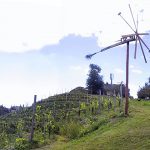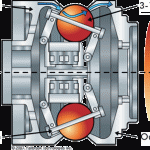- Dissertations on fab labs and maker culture. [Cindy Kohtala] “A list of doctoral dissertations and master’s theses on open design, fab labs, makerspaces, digital fabrication, 3D printing, maker culture, etc.. Contact me to add yours, and sorry if I missed it!”
- Introduction: Alternative Histories in DIY Cultures and Maker Utopias. [Digital Culture & Society] “Activities considered “low-tech”, the non-digital in DIY (Do-It-Yourself) cultures, are often pushed aside in the rush to promote the most photogenic high-tech tools, such as 3D printers, laser cutters and computer numeric-controlled (CNC) routers.”
- Solar Generator Trailer- Electrical System. [Low-tech Lab] “This tutorial presents the sizing and construction of an electrical system for a solar generator (1 kWp or ‘kilowatt peak’) which can be moved by bicycle. This structure was designed to fit on the CHARRETTE, an assisted trailer designed by the Véloma association, whose plans are freely available.”
- Opportunities of living in an urban and low-tech environment. [Low-tech Lab] “Andréane Valot, designer and graduate of ENSCI – Les Ateliers in 2021, shares her assessment of 8 months of experimentation with a low-tech approach to life in an urban environment, in this case applied to her Parisian studio.”
- Rower generator. [Gene’s Green Machine] “I thought it might be a fun challenge to build a rowing machine generator.”
- The Anti-Ownership Ebook Economy. [The Engelberg Center on Innovation Law & Policy] “Something happened when we shifted to digital formats that created a loss of rights for readers. Pulling back the curtain on the evolution of ebooks offers some clarity to how the shift to digital left ownership behind in the analog world.”
- How to generate an Ourzine pdf? [Ourzine] “Ourzines are a way for people to connect with written text without the distractions of digital screens. By refocusing our attention from the unending onslaught of new content to paper, Ourzines give readers the space to choose what they want to engage with and to do so mindfully. No links, no ads, no rabbit holes – nothing but what you have decided to read.”
- Reviving Chromebooks with Ubuntu: Autonomous Servers, Planned Obsolescence, and Permacomputing. [Anarcho Solarpunk] “A tutorial and slight manifesto on reviving end-of-life Chromebooks. How to make them into autonomous servers, and why we need to rethink computing in the age of climate collapse.”
- The buttons on Zenith’s original ‘clicker’ remote were a mechanical marvel. [The Verge] “The Zenith Space Command, one of the first wireless television remotes ever to exist, is a monument to a time before we took the remote for granted. It also just so happened to contain one of the most influential and intriguing buttons in history.”
- Version 2 of my solar-powered, ePaper digital photo frame. [Plotting The Curiosity Vector]
- The myth of neutral tech and the politics of not doing in the attention economy. [Center for Transdisciplinary Gender Studies] “When performance is increasingly monitored, output and achievement glorified, inactivity deemed laziness and laziness deemed undesirable, doing nothing can be a radical act.”
- Clicks of Desire – How the Internet obeys you. [The New Atlantis] “Where once it was occasionally possible to opt out of ‘reality’ (by taking drugs, say), it is now increasingly necessary to think about how to opt in to it.”
- Who Makes Our Smartphones? Four Moments in Their Lifecycle. [The Routledge Handbook of Ecomedia Studies] “We hope we have provided reasons for holding on to smartphones for as long as possible, if for no other reason than to help release some of the pressure on workers laboring across the supply chain.”
- Low-tech et sobriété numérique: une étude d’usages du smartphone. [Université du Québec à Montréal] “Afin d’interroger la sobriété d’une
high-tech, nous nous sommes concentrés sur le smartphone; objet emblématique du quotidien, autour duquel nous avons mené un travail de design. Nous avons ainsi mis au point une pellicule de sobriété numérique, qui permet de flouter l’écran et gêner l’usage du smartphone, créant ainsi une barrière entre l’usager et son objet high-tech. Notre objectif de recherche est d’étudier les effets et la potentielle diminution d’usage quotidien de ce dispositif.”
No Tech Reader #41
How to heat your cabin with steam?
This is a guest post by Mikhesh The Steamer.
It does not have to be just about the winter regarded with apprehension, which did not prove to be as much problematic in Europe at all. In the outlying hills, there is a lack of electricity or gas source. On the other hand, there is usually water and wood nearby. A steam heater can be assembled from things you find in a garbage dump, thrown away in a workshop or in a hobby market.
In a cabin with a fireplace after thirty minutes, the temperature is at best slightly higher, but with steam heating, a T-shirt is enough for that time. You can also spread the steam behind several corners and you don’t have to rely on heat radiation. Wood consumption is equal to a regular fireplace. The difference is in how we deal with its energy.
Human Powered Fire Making
People made fire by hand for many thousands of years. We improved the energy efficiency of the process by letting the legs do the work. Unlike modern lighters, the lighter bike does not use fossil fuels. Lighting a cigarette takes about a minute of brisk pedaling.
No Tech Reader #40
- Out of the wild. [The New Atlantis] “The ideal of nature as it used to be before human intervention is one that Western urbanites created in the late nineteenth century, chiefly as a foil for their own modernity… This vision still permeates much of environmentalism and stands in the way of responsible action toward nature, particularly in the places where we actually live.”
- Minds on Fire: Cognitive Aspects of Early Firemaking and the Possible Inventors of Firemaking Kits. [Cambridge Archaeological Journal] “We analyse aspects of the two main hunter-gatherer firemaking techniques—the strike-a-light and the manual fire-drill—in terms of causal, social and prospective reasoning.”
- The Kayak’s Cultural Journey. [Craftsmanship Quarterly] “For millennia, Indigenous peoples across the world have built and used skin boats to fish and hunt, for sport and travel, even for warfare. Now non-Indigenous admirers of the craft are making them, too.”
- Permacomputing Aesthetics: Potential and Limits of Design Constraints in Computational Culture. [LIMITS 2023] “Permacomputing is a nascent concept and a community of practice oriented around issues of resilience and regenerativity in digital technology. At the heart of permacomputing are design principles that embrace limits and constraints as a positive thing, as well as being creative with available computational resources.”
- Building and Monitoring a SolarPowered Web Server. [ETH zürich] “In this thesis we focus on building a solar-powered web server. We present existing websites which are fully or partially solar powered, introduce some background about battery state of charge estimation and how to determine the right solar panel and battery size. Reusing components from older projects, we host a static website on an exemplary setup, which is solely solar powered.
Human Powered Record Player
Low-tech Magazine’s bike generator powers a record player. No batteries are involved: a buck converter in the control panel keeps the voltage output constant at 12V. Power use is very low and pedaling is easy. Record: Jean-Jacques Perrey et son Ondioline.
Build your own bike generator.
We also published a video of our pedal powered video projector.
Human Powered Dot Matrix Printer
Human-powered dot-matrix printer. Direct power. No batteries are involved. Directly powering a dot-matrix printer is challenging, especially when printing longer documents. The power demand is variable and can increase suddenly for a short time. You must pedal very fast to anticipate these peaks. If you fail, the voltage drops, the communication between the printer and the laptops breaks down, and the machine prints the document all over again. Capacitors could solve this. A laser printer has a very high power use during startup and is incompatible with a bike generator (or a small-scale solar installation).
DIY manual for the bike generator: https://www.lowtechmagazine.com/2022/03/how-to-build-bike-generator.html.
History of office equipment: https://www.lowtechmagazine.com/2016/11/why-the-office-needs-a-typewriter-revolution.html






